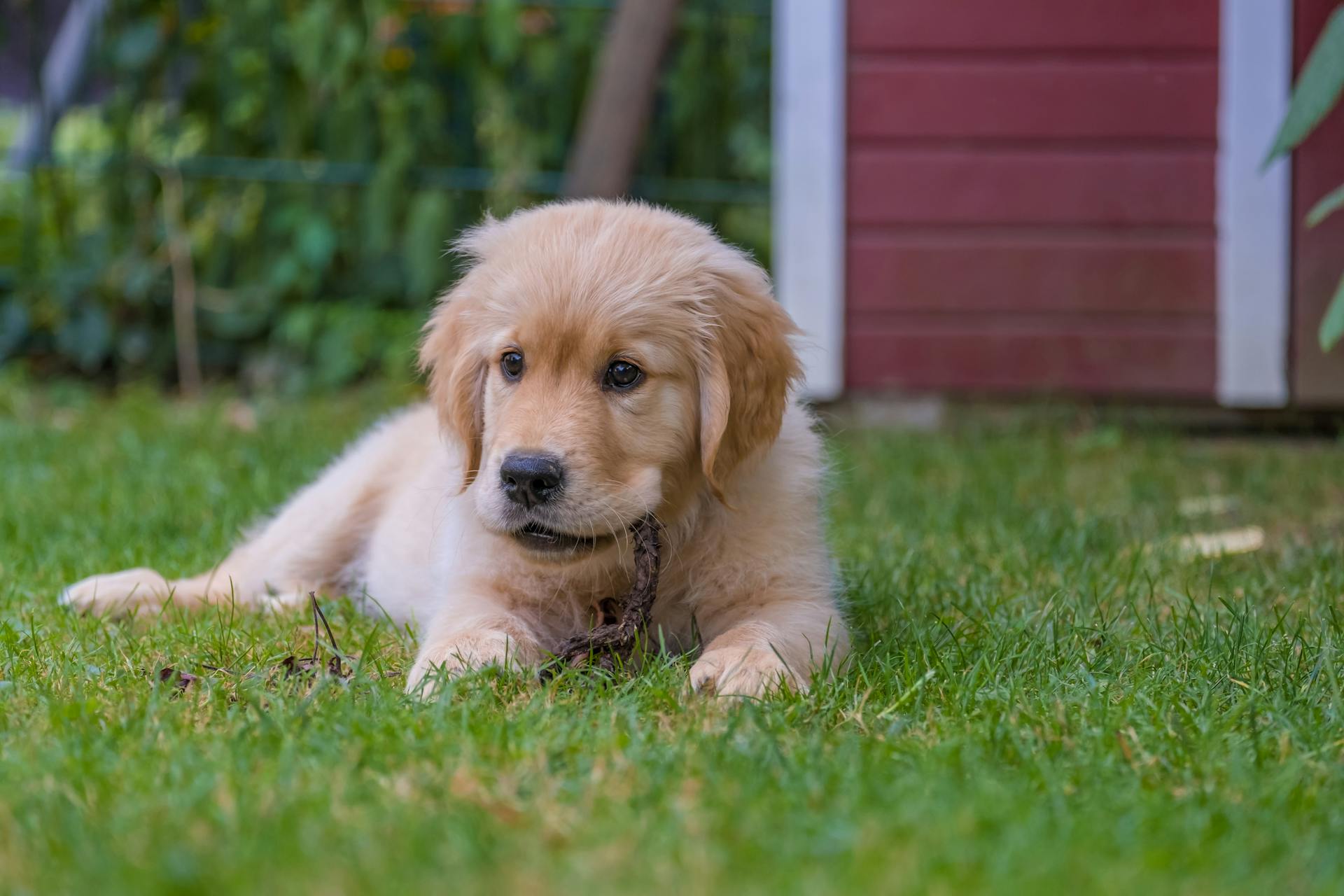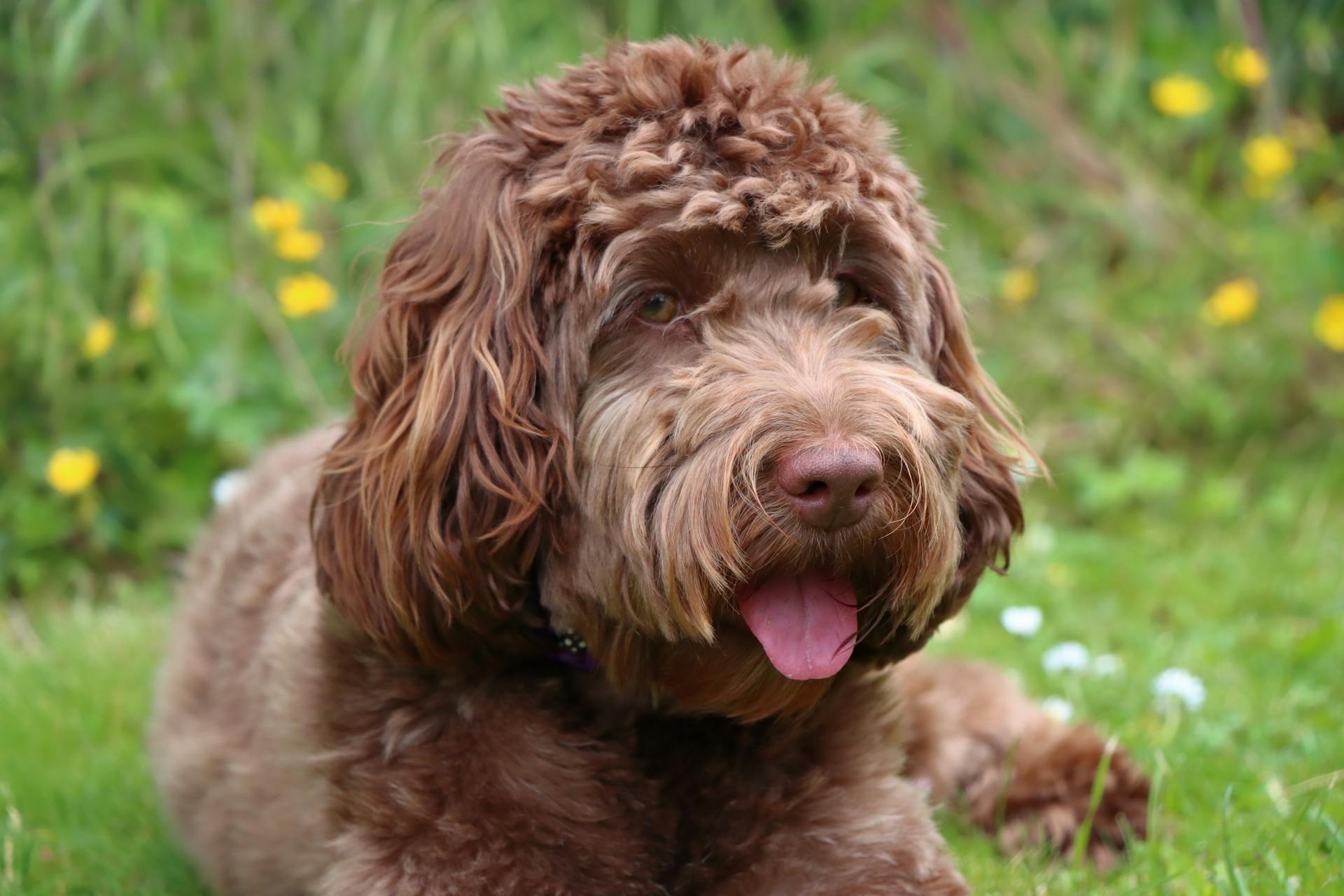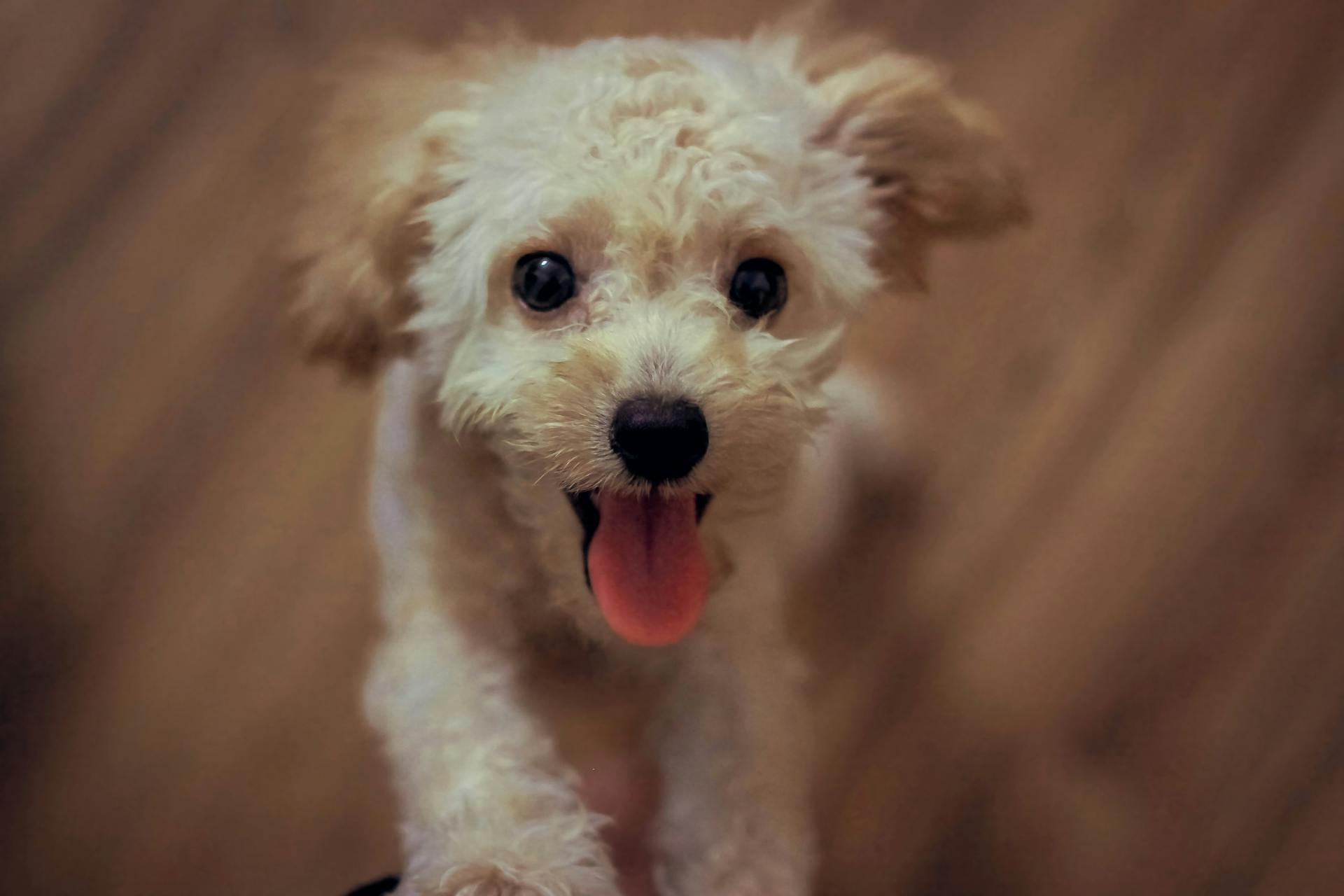
Whoodles are a crossbreed between a Poodle and a Soft Coated Wheaten Terrier, making them a unique and lovable companion.
Their intelligence and trainability make them a great choice for first-time dog owners.
Whoodles typically weigh between 20-45 pounds and stand between 18-24 inches tall.
They have a low-shedding coat that requires regular grooming to prevent matting.
Their friendly and outgoing personalities make them a great fit for families with children.
Whoodles are generally good with other pets, especially if socialized from an early age.
Their high energy levels require regular exercise to keep them happy and healthy.
Regular walks, playtime, and mental stimulation are essential for a happy Whoodle.
Feeding and Nutrition
Whoodles are unique, and their dietary needs can vary greatly depending on their size, age, and health history. Partner with your veterinarian to develop a feeding plan that's tailored to your pup's individual needs.
Their coats may not shed much, but Whoodles require daily brushing and combing to prevent matting. This should be done every day, as their curly coats can easily become tangled.
Feeding your Whoodle should be done with care, as they may require more than two meals a day. Whoodle puppies, for example, have a higher metabolism and typically need three daily meals.
The amount to feed your Whoodle depends on their weight, body condition score, lifestyle, and health needs. You can find a general idea on the nutrition label, but it's best to consult with your veterinarian for an accurate amount.
Most adult dogs should eat twice a day, but Whoodles may require more frequent meals. Whoodle puppies, in particular, need three daily meals to meet their high energy needs.
If your Whoodle is eating a dog food that meets AAFCO standards, they shouldn't need any extra supplementation. However, nutritional supplements or prescription diets may be necessary to treat or prevent certain health conditions.
Here's a general guideline for feeding your Whoodle:
Keep in mind that this is just a general guideline, and you should consult with your veterinarian for a personalized feeding plan.
Health and Wellness
Whoodles are generally considered to be healthy dogs, but like any breed, they can suffer from some common health issues. As a responsible owner, it's essential to be aware of these potential problems.
Whoodles can inherit health issues from their parent breeds, including poodles and soft-coated Wheaten terriers. This means they may be prone to hip dysplasia, Addison's disease, and eye problems, as well as protein-losing nephropathy and protein-losing enteropathy.
Regular veterinary checkups and good care can help prevent or manage these issues. Some common health problems Whoodles suffer from include eye infections and diseases, kidney issues, Addison's disease, and retinal atrophy.
Here are some common health issues Whoodles can suffer from:
- Eye infections and diseases, such as conjunctivitis, keratitis, glaucoma, and cataracts.
- Kidney issues, including kidney stones, renal failure, and urinary tract infections.
- Addison's disease, also known as hypoadrenocorticism, which occurs when the adrenal glands fail to produce enough cortisol and aldosterone.
- Retinal atrophy, which refers to the degeneration of the retina.
A reputable breeder will DNA test both parent breeds to ensure they are free of mutated genes that could cause diseases in their offspring.
Health Issues
Whoodles are generally considered to be healthy dogs, but like any breed, they can be prone to certain health issues.
Some common health problems Whoodles suffer from include eye infections and diseases, kidney issues, Addison's disease, and retinal atrophy. These conditions can be inherited from their parent breeds, the Soft Coated Wheaten Terrier and the Poodle.
Eye infections and diseases can cause symptoms such as redness, discharge, cloudiness, or vision changes, and treatment varies depending on the specific condition.
Kidney issues, including kidney stones, renal failure, and urinary tract infections, can cause symptoms like increased thirst, frequent urination, lethargy, and loss of appetite.
Addison's disease, also known as hypoadrenocorticism, is a hormonal disorder that occurs when the adrenal glands fail to produce enough cortisol and aldosterone. Symptoms include lethargy, weakness, vomiting, diarrhea, and weight loss.
Retinal atrophy refers to the degeneration of the retina, the light-sensitive tissue lining the back of the eye.
To minimize the risk of these health issues, it's essential to work with a reputable breeder who has performed DNA testing on their parent dogs to ensure they are free of mutated genes. They should also have their hips and joints checked to ensure above-average scores and a minimal risk for dysplasia.
Here are some common health issues that Whoodles may be prone to:
- Eye infections and diseases (conjunctivitis, keratitis, glaucoma, cataracts)
- Kidney issues (kidney stones, renal failure, urinary tract infections)
- Addison's disease (hormonal disorder causing lethargy, weakness, vomiting, diarrhea, and weight loss)
- Retinal atrophy (degeneration of the retina)
Life Expectancy
The life expectancy of a Whoodle is a topic of interest, especially for new dog owners. The average life expectancy of a Whoodle is between 12-15 years.
The lifespan of a Whoodle is based on the average lifespan of its parent breeds, the Poodle and the Wheaten Terrier. Both of these breeds have an average lifespan of 12-15 years.
While there have been no studies specifically on the life span of Whoodles, the numbers above are a reliable estimate. This is because the Whoodle breed has only been recognized for approximately ten years.
Hybrid dogs, like Whoodles, may have an extended average life expectancy compared to purebred dogs, thanks to the "Hybrid Vigor" factor.
Readers also liked: Whoodle Lifespan
Are Hypoallergenic?
For families with allergies, it's great to know that Whoodles have a soft silky non-shedding coat that is hypoallergenic.
Both parenting breeds of Whoodles are 100% Hypoallergenic, so there's no chance of inheriting an undesirable coat.
Their hypoallergenic coat makes them a great choice for families with young kids or anyone who suffers from allergies.
Behavior and Training
Whoodles are highly social animals that thrive on attention and interaction. They need close companionship and daily exercise to stay happy and healthy.
Their exercise needs depend on their size, with larger Whoodles requiring more energy to burn. Consistency is key when it comes to exercise, so establish a regular routine that suits your pup's needs.
Whoodles are intelligent and trainable, but they can be stubborn at times. Positive reinforcement is the best method for training, using praise, treats, and affection to reward desired behavior.
Their intelligence allows them to pick up commands quickly, but early training is crucial to establish good behavior from the start. Keep training sessions short and fun, around 10-15 minutes, to avoid boredom and repetition.
Whoodles have a high prey drive, so it's essential to keep them on a leash or in a fenced-in space when outside. They also need mental stimulation to prevent restlessness and destructive behavior.
Here are some key traits to keep in mind when training your Whoodle:
- Be consistent with commands and routines.
- Keep training sessions short and fun.
- Provide mental stimulation through puzzle toys, obedience training, and interactive games.
Remember, every Whoodle is unique, and their temperament may vary depending on their individual personality. Volhard Temperament Testing can help you determine the natural character of your puppy, whether they're reserved, playful, independent, or outgoing.
Grooming and Appearance
Whoodles have a unique appearance that sets them apart from other breeds. They can range in size from 20 to 45 pounds, depending on the size of their poodle parent.
Their coat is silky and curly, with a wide range of colors including brown, gray, black, white, and gold. Whoodles are low-shedding, but their coats require daily attention to prevent matting.
To keep their coat looking its best, Whoodles need to be brushed and combed several times a week. They also need to be bathed every month or as needed, using a gentle dog-friendly shampoo.
Here's a quick grooming schedule to keep in mind:
- Brush 3-4 times a week
- Bathe every 4-6 weeks
- Trim every 4-6 weeks
Regular grooming is crucial to prevent matting and tangling, especially in areas like the ears, armpits, and behind the legs.
Living with a Whoodle
Living with a Whoodle is a joy, as long as you're prepared to give them the attention and exercise they crave. Whoodles are happiest when receiving attention and love to join their owners for daily physical activity, such as long walks, swimming, or playing games.
They thrive on companionship and love being part of family activities, making them wonderful playmates for children. Whoodles are known for their sociable personality and typically get along well with other pets, including dogs and cats, when properly socialized from a young age.
Whoodles are adaptable to apartment living, but they do require daily activity with their owners. They love to snuggle and cuddle on the couch, but also enjoy interactive play, such as fetch or hide-and-seek.
Living Needs
Whoodles are happy to live in apartments as long as they get enough daily physical activity. They love long walks, dog puzzles, swimming, or playing games with their favorite person.
They desire daily activity with their humans and other animals, and they're happiest when receiving attention. Whoodles make easy-going companions for almost any situation.
Most whoodles prefer to join you for nearly any activity, so be prepared to include them in your daily routine. If you're someone who likes to stay active, a Whoodle is a great companion for you.
Whoodles can be strong-willed and independent, which means they might jump on people for attention. But with patient training and positive reinforcement, they can learn to have good manners and be happy, agreeable pets.
Whoodles shouldn't be left alone for long periods of time, but they don't need you to lie around the house with them all day. They're happy to join you for activities, as long as they're well-trained and socialized.
Family Compatibility
Whoodles are exceptionally compatible with families due to their friendly, affectionate, and adaptable nature.
Their sociable personality typically means they get along well with other pets, including dogs and cats, when properly socialized from a young age.
Whoodles thrive on companionship and love being part of family activities, making them wonderful playmates for children.
They usually handle the hustle and bustle of family life well, and they often enjoy interactive play, such as fetch, hide-and-seek, or simply running around the yard.
Whoodles are known to be fairly quiet, with minimal amounts of barking.
They love to snuggle and cuddle on the couch just as much as they love to go on hikes and be part of the family.
Rescue Groups
Living with a Whoodle can be a rewarding experience, but it's essential to consider the rescue options available for this mixed breed.
Unfortunately, Whoodle rescue groups are scarce, but don't worry, there are alternatives to try.
You may want to reach out to Soft-Coated Wheaten Terrier breed-specific rescues, as they often care for mixes.
Here are some rescues you can try:
- S’Wheat Rescue & Adoptions
- Poodle Club of America Rescue Foundation, Inc
Whoodle Characteristics
Whoodles typically stand between 12 to 20 inches tall at the shoulder, making them a medium-sized breed.
Their weight range is also relatively consistent, with most Whoodles weighing between 20 to 45 pounds.
This breed has a lifespan of 12 to 15 years, which is a decent amount of time to enjoy the companionship of a Whoodle.
Here are some key physical characteristics of Whoodles:
Origin of the Whoodle
The Whoodle's origin story is a fascinating one. The first Whoodles were bred in the mid-1900s to combine the natural intelligence and workability of the Poodle with the alluring fur of the Soft-Coated Wheaten Terrier.
They are a relatively new breed still in the making, which means they are still evolving.
Characteristics
Whoodles are a wonderful breed, and understanding their characteristics is essential for any potential owner. They come in a variety of sizes, ranging from 12 to 20 inches in height at the shoulder.
Their weight can vary from 20 to 45 pounds, making them a great fit for many living situations. This adaptability is one of the reasons why Whoodles are such a popular choice for families and first-time owners.
Whoodles have a relatively long lifespan, living up to 12 to 15 years. This means they'll be by your side for many happy years, providing love and companionship.
Here's a quick summary of Whoodle characteristics:
Their friendly and adaptable personalities make them a great fit for people living in small or large homes, and they're compatible with various lifestyles.
Dog Size
Dog size can vary significantly in Whoodles, but they generally fall in the medium size range. Their height typically ranges between 12 to 20 inches at the shoulder.
Whoodles can weigh anywhere from 20 to 45 pounds, depending on their lineage and size variation. This means that some Whoodles can be on the smaller side, while others can be quite larger.
The size of a Whoodle is influenced by the size of its Poodle parent. Standard Whoodles tend to be larger, while Miniature Whoodles are usually on the smaller end of the scale.
A unique perspective: Whoodle Size
Frequently Asked Questions
Are Whoodles low maintenance?
No, Whoodles are not low-maintenance dogs. They require regular exercise, training, and grooming to stay happy and healthy.
How much does a Whoodle dog cost?
A Whoodle puppy typically costs between $1,000 and $2,000. Research thoroughly before purchasing to ensure a safe and healthy addition to your family.
Do whoodles bark a lot?
Whoodles may bark occasionally due to anxiety or boredom, but excessive barking is not typical of the breed. Providing enough attention and stimulation can help prevent unwanted barking behaviors.
Featured Images: pexels.com


